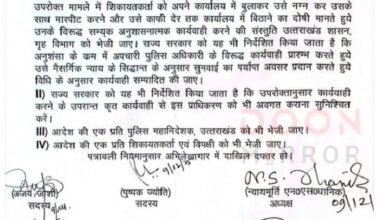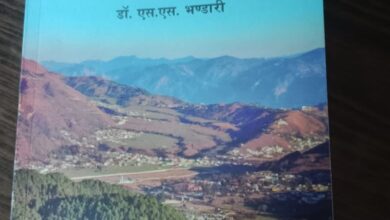Fallout : Power, Intrigue and Political Upheaval in Pakistan
Book Review

Fallout: Power, Intrigue and Political Upheaval in Pakistan
Book Review by Rashme Sehgal
New Delhi, June 26
Fallout is a gripping account of the rise and fall of Pakistan’s blue-eyed celebrity, ace cricketer turned politician, Imran Khan while covering a tumultuous period in Pakistan’s history between 2014-2024.
Pakistani journalist Salman Masood, editor at The Nation and correspondent for the New York Times from 2003, provides an insider’s view into the intricacies and wheeling-dealing that goes on in Pakistan’s powerful military establishment which plays one political group against another. Even as the book focuses on how the army and other power groups attempts to steer Imran Khan’s government towards a presidential system of governance through some clever image building, their best efforts get disentangled by Khan and his senior party colleagues because of their amateurish understanding of governance and foreign policy, The book also looks at the parallel careers of the Sharif brothers and of Asif Zardari and his son Bilal Bhutto while also providing some interesting asides on other important players such as Maulana Fazal-ur Rehman and veteran parliamentarian Sheikh Rashid.
`Fall Out’ comprises of a series of articles written between 2014 and 2024 starting with June 2014 when Imran Khan threw in his gauntlet on June 27 to organise a massive protest march to Islamabad in order to highlight the issue of election rigging by Nawaz Sharif. The problem is that Nawaz Sharif is like the cat with nine lives having returned to power in 2013. His astuteness as a politician can be gauged from the fact that he is back in power once again.
The June 2014 protest did not gain the momentum Khan had hoped for but like two gladiators caught in a stadium, Khan and Nawaz Sharif continued to joust against each other for an extended period of time during which both achieved prime ministerial positions and then went on to lose them.
The problem with politicians across South Asia is that there is little learning curve in their behaviour. They will plot and manipulate to come to power and when they succeed, it takes little time for power to go to their head. Each of these leaders, Khan and Sharif, as is the case with many others, tend to operate through a small fawning coterie completely disconnected from the reality on the ground. The rise to power may have been gradual but the fall is swift and in some cases fatal.
This happened with Sharif during his second tenure. This happened with Imran Khan who promised a corruption free prime ministership. But in no time at all, he encircled himself with a coterie of flatterers who played up to all his religious shenanigans. Arrogance and hubris define the way these leaders conduct themselves and this seems to be the record of leaders across South Asia.
The book highlights how in 2014, Imran organised two major protests, the first in June and then a subsequent one in November against the Nawaz Sharif government. Both turned out to be flops. The Sharif government should have capitalized on the failings of its formidable opponents but they too failed to seize the initiative. The problem with the Sharif government was that it seemed to be losing control. There was the Army Public school massacre and later attack on a university and in a court complex in Charsadda. The leakage of the Panama papers also proved damaging for the Sharif family. The Pakistani army was watching all these shenanigans with great interest. In November 2016, Sharif ended months of speculation by announcing Lt Gen Javed Bajwa as army chief. Bajwa was a firm believer in civilian supremacy and was known for his liberal outlook.
The Panama Papers exposure case was taken to the Supreme Court in April 2017 which asked for the setting up of a Joint Investigation Team comprising civil and military investigators to probe into the financial affairs of the Sharif family. In July 2017, the Supreme Court disqualified Sharif from public office. His daughter Maryam Nawaz Sharif was also implicated in this. The decision of the Supreme Court suited the generals who had never been happy with Nawaz Sharif’s insistence on `civilian supremacy.
Elections were finally held in July 2018 and it was clear that this time around Imran would win. The army believed that the removal of the two mainstream parties from the power scene and giving a chance to Imran Khan might help solve the country’s problems. Nawaz Sharif did try and lift the morale of his party PMN- L but it was Imran Khan’s party that ended up emerging as the single largest party.
It is a gripping and interesting book which seemingly involves the reader completely. It goes behind the scenes to cover the intricacies and intrigues in Pakistani politics, with the powerful military establishment often treating the political leadership as marionettes. The author clearly establishes how in Pakistan each power centre is not independent and needs each other. The current international environment does not support military coups and takeovers so in Pakistan, the military, the politicians and the establishment with their wheeler dealers and power brokers worked together to make and unmake leaders.
Ultimately, it was the military which created a Frankenstein named Imran Khan, who although created by the military, ultimately turned against them and even tried to destroy them. It clearly shows how Imran Khan allowed power to go to his head and this led to his downfall. Other powerful Pakistani families remained more cautious in their political dealings. Clearly Imran’s ambitions were much higher than his political acumen.
The problem with stringing together articles is that the timeline of the events that have been strung together seem sometimes to be disjointed or not linked together which can confuse the reader. The author makes one very interesting observation that sums up the state of politics in the country. Masood writes, `It is astounding how easily a political government gets upended. Politicians who have ruled for decades, appear as clueless and laypersons when it comes to dealing with the issues of governance and the economy.’
All the major characters of the book including the subdued but Machiavellian army Chief Kamal Bajwa, the Sharif family, important events like Panama papers exposure, the removal of Nawaz Sharif as prime minister Pakistan by Pakistani courts following the Panama papers exposure are covered in some detail. Imran Khan enjoys pride of place, but turns out to be a maverick blinded by megalomania and ambition.
The book captures Khan’s rise to power but by November 2018, when his government had completed 100 days, it became apparent that his ministers were men with little administrative experience. One year later, his government was seen to be flailing and failing. The economy has begun to unravel with the country having picked up a debt of $10.6 billion. Foreign investors were shying away from making investments. In August, Khan gave a three year extension to the army chief Bajwa. But eighteen months later, relations between these two began to unravel.
The very army that supported Imran in his rise to power was now being looked upon with suspicion by him. Things came to a head in a circuitous manner. Khan’s protégé Usman Buzdar, the powerful chief minister of Punjab was forced to put in his papers. With Opposition parties intensifying their effort for Khan’s removal, Khan decided he wanted to pursue an independent foreign policy and move Pakistan away from the grip of the US so he went off on a high- profile trip to Russia. Khan’s anti-West rhetoric may have gone down well with the public but the army took a serious view on this matter. A bitter falling out took place between him and Bajwa and his intelligence chief and Khan went to the extent of publicly accusing the ISI of having master minded the gun attack on his life in October 2022.
The climax to this was when on May 9 2023, protesters belonging to Khan’s party entered the Lahore Corps Commander Lt. Gen Ghani’s house in Lahore indulging in looting and vandalism. Ghani had misread the situation and thought they would hold a peaceful protest which was not the case. This led to Ghani’s court-martial and dismissal from service. The protestors were angry at the arrest of their leader Imran Khan having been arrested but it soon became obvious that these protestors had overplayed their hand. Even his ardent supporters within the army were disillusioned with his tactics. All the powerful groups within Pakistani society namely the middle class, business community and the military elite desired stability. They decided to put their put down and came down hard on both Imran Khan and his party members.
The best laid plans of mice men often go awry, cometh the hour cometh the man, This definitely was the case with Imran Khan who wanted the numero uno position at any cost without understanding his own limitations. When the top brass of the Pakistan army realized Imran Khan was proving a disaster, they engineered his downfall and worked out a deal with Nawaz Sharif’s brother Shabazz Sharif to instal him as Prime Minister of Pakistan.
Khan was incarcerated in the notorious Attock jail and then moved to the high-security Adiala prison in Rawalpindi. The Election Commission went ahead and stripped Khan of his party symbol the iconic ricket bat. Despite this clampdown, on Feb 8 2024, his party emerged as the largest party in the national elections but the army is no mood to hand over power to his followers.
Pakistan’s politics remains in a state of flux. For the present, it is the Sharif family which is riding high but no one is willing to write Imran Khan off. Khan is biding his time hoping that the future will prove kinder to him. Let us see.
( Rashme Sehgal is an independent senior journalist.)





